Our Wandering Sommelier, Shalom Chin, investigates the English wine following the trail from the Wine Pantry at Borough Market and out into the field in Kent and Sussex. And he’s impressed with what he sees – read on…
English wines are starting to make the news more frequently over the past few years after producers like Nyetimber’s 1998 Blanc de Blanc won a gold at 2009’s Chardonnay du Monde and other estates such as Gusbourne and Furleigh Estate clinched Silver at the Effervescents du Monde 2011. Perhaps one of England’s most prominent wins so far is the Ridgeview Estate 2006 Grosvenor Blanc de Blanc for best Sparkling wine at Decanter’s World Wine awards. What is going on in the English wine industry? I head to the Wine Pantry in London to find answers.
04/04/2012
Many people may not be aware, but wines with bubbles may not actually have started in Champagne as many would think, but England. The process of Sparkling wines was first recorded in 1662, where a scientist named Christopher Merrett explained to the Royal Society of London how adding sugar to wine produced bubbles. Merrett’s findings were based on the English’s love for cider production. Some believe that the British were adding fizz to wines imported from Champagne a decade before sparkling wines were produced in France.
In the 15th century, Monasteries in England were making wines but when Henry VIII separated the Church of England from the Catholic Church, the monasteries were abolished and the wine industry died with it. After six centuries, we are seeing a resurgence of wines produced in England and no longer in monasteries. The 1950s saw Hambledon as the first winery, followed by Nyetimble in the Seventies. There was an explosion of plantings in the Nineties due to rumours of restrictions in the form of permits needed to plant grape vines.
As of today, England has 403 wineries with a total production last year of 4 million bottles of still and sparkling wine. This is expected to grow tremendously to an additional million now that Rathfinny Estate has just purchased 160 hectares of land near the coast at Alfriston, East Sussex, just 141 kilometres from Champagne in France. Perhaps there is no better timing for English wine industry to enter the wine game with the onset of global warming over the last century.
With a climate that is extremely cold, the weather is subjugated to the vagaries of rain and the lack of sunshine. It is possible that we are looking at the same climatic conditions which were similar to what Champagne was experiencing two to three centuries ago. Ripening of grapes throughout the world is getting earlier over the last decade with harvest in England starting from early to late October. In fact, the soils of Kent, East Sussex and Hampshire are almost similar to Champagne’s chalky soil. Let us not forget that whites, reds and rosé wines are also produced at Gloustershire, Wiltshire, Worcestershire and Warwickshire from exotic grape varieties such as Seyval Blanc, Bacchus, Madeleine Angevine, Kerner and Reichensteiner. These are mostly frost-hardy and early ripening varieties. The country also produces wines from more commonly used grapes such as Cabernet Sauvignon, Pinot Noir, Pinot Gris, and the latest being Malbec, which is grown and made into wine by Chapel Down in Kent.
I headed down to the Borough Markets at the South of London to find out more.
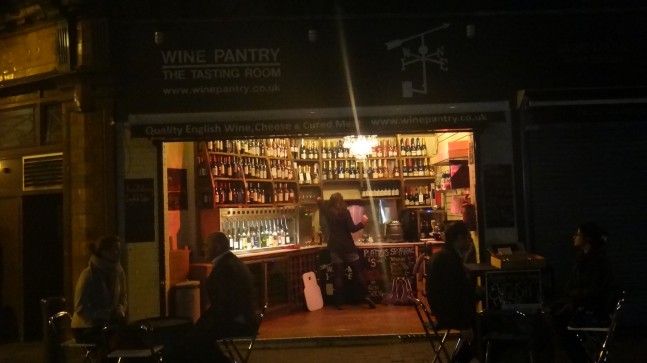
A genial atmosphere tasting English wines alfresco at the Wine Pantry
The Wine Pantry www.winepantry.co.uk
The Wine Pantry is London’s first and only specialist wine shop and tasting room specialising solely on English wines. The shop is located near the London Bridge Tube station and is only a 5 minute walk away from the station if you take tunnel heading towards Borough Street. It is the only wine shop in the vicinity that uses wines-by-the-glass dispensers to allow customers to taste 6 wines from a range of English wines brought in from all over the country for just £5. They are the only shop I know in London to have the widest range of English Sparkling wines with 24 different labels. Anyone who wishes to receive an introduction to English wines and try out wines made from exotic grape varieties should pay them a visit.
The shop is the brainchild of Julia Stafford who used to work in the oil and gas industry before leaving her job in 2010 to open the store in May 2011 – coincidentally the same time as English wine week. She has a deep interest in sustainability and is completing her Masters of Science in Environmental policy at Imperial College. Initially, she wanted to start a carbon-neutral pub but lacked a suitable location. The idea of an English wine tasting room came when she realised that there none in London or England that features English sparkling wines for tasting, education and purchase from a single place. Since Chapel Down, Ridgeview, Camel Valley and Nyetimber are all big names supported by local supermarkets, the other wineries needed an outlet to feature their wines, apart from just relying from cellar door sales. Thus, the Wine Pantry was born.
The store is also managed by highly knowledgeable and passionate staff. Dominique Hopgood is the store’s general manager and has an infectious enthusiasm to get you excited about English wines. Coupled with her immense knowledge about the regions and wines in the country, she has an amazing memory of production methods of each wine sold at the store and a story to go along with each wine. Constantly, there are curious customers from around the world popping in. They would walk in with a surprised look that England actually produces wine, only to be greeted with tasting samples and warm hospitality, and then leaving with both a new-found appreciation of English wines and a bottle.
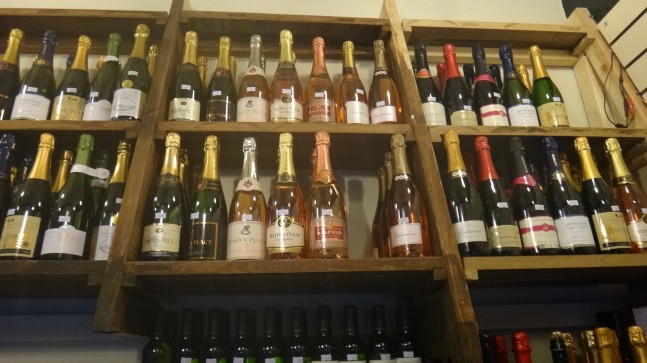
The Wine Pantry has the widest range of English bubblies I have seen in London
When it comes to selecting the wines for the pantry, the team does a lot of research by tasting and looking at price points, but the most important deciding factor would be to select wines which are good and positive representations of the industry. Six precent of the English wineries are represented in the store. Establishing themselves as a serious advocate of English wines in such a short period of time, wineries across England are now seeking them out. Supermarkets too are seeking their recommendations on English wines to put on their shelves.
English Wine Notes:
|
Out in the Field
I headed down to Kent and Sussex mid-July last year to see the development of the vines. Unlike Champagne, the vines are planted more widely. Wire trellis systems are employed but we also find other types of canopy management such as Geneva double curtain and lyre system. More leaves are left on the vines to capture whatever sunlight the vines can savage from the already incremental weather for the development of the grapes. At the same time, too many leaves will lead to poor air circulation inside the vine’s canopy and disease can affect the vine. This is why Chaptalisation is permitted as they struggle is to get grapes ripe. Reaching sugar levels of 12° Baumé can be a challenge.
Climate and temperature are the vagaries of English viticulture. According to Dominique, 2011 had a hot spell followed by some rain, causing a loss of two-third of the grapes from June to August. However, sugar levels are of acceptable levels.
English Wine producers are already starting to break new ground and it would be foolish to ignore them as strong competitors in producing quality wines with warmer temperatures heading northwards due to climate change. Eglantine from Nottingham Shire has already produced England’s first Ice wine made from Madeleine Angevine called North Star for its 2006 vintage, which is retailing at €32. The wine is made using Cryo-Extraction and there are only 1000 bottles made.
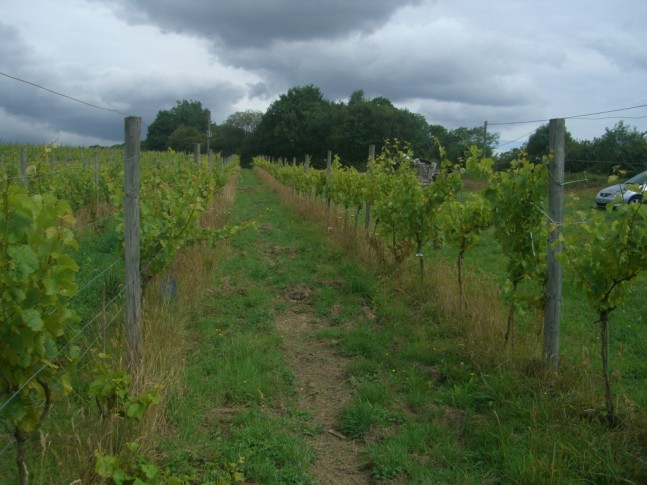
An English winery north of Kent There are usually more leaves on the vine and lower planting densities
What are English wines like?
I ask Dominique if English wines were considered new world or old world. She believes that English wines are a new industry and should not be put in either the old or new world camps, but should be considered as new frontier wines.
“England is trying to produce wines of quality rather than quantity and wines that can compete on the shelves against the more expensive brands. We are now seeing an increase in the average price of still wines on the shelves. The very young are drinking more wines and getting into the culture. The snootiness of wine drinking is decreasing and people are getting more comfortable to learn. People are self-conscious due to the greenness in their knowledge”, she says. “England should not follow to be like Champagne, but be themselves.”
In her opinion, if one were to generalise English wines, the profile would be aromas and flavours of elderflower, hawthorn blossom, and English strawberries. It is delicate on the nose but light and tingly on the palate. It reminds her of being in the countryside with hedgerows, floral and herbaceous growth on a warm summer day.
For me, I find English wines to offer much more on the palate than on the nose. I also find the wines I have tasted to have very unique flavours such as mangosteen, aloe vera and coriander. These are flavours which are not your typical fruit-driven wines but they have an affinity to match many Asian cuisines which are savoury or have herb flavours such as Bak Kut Teh (a herbal broth of pork ribs). The low alcohol and high acid allows one to enjoy spicy dishes such as Singapore Pepper Crab without the extra alcoholic heat and with enough acid to cut through most dishes. I am quite impressed with the Quality-Price-Ratio of their sparkling wines. Their white wines are starting to grow on me with their unique flavour and low alcohol. However, I feel that their red wines have more room to improve in terms of tannin structure, flavour weight and ripeness.
With the growth of English wines, it may be soon that we will see people turning towards English wineries for export to the international markets. Break Bottom is already exporting to Japan and Gusbourne to the United States. It is just a matter of time before the word gets around.
For more information on UK wine regulations, go to http://www.ukva.org.uk
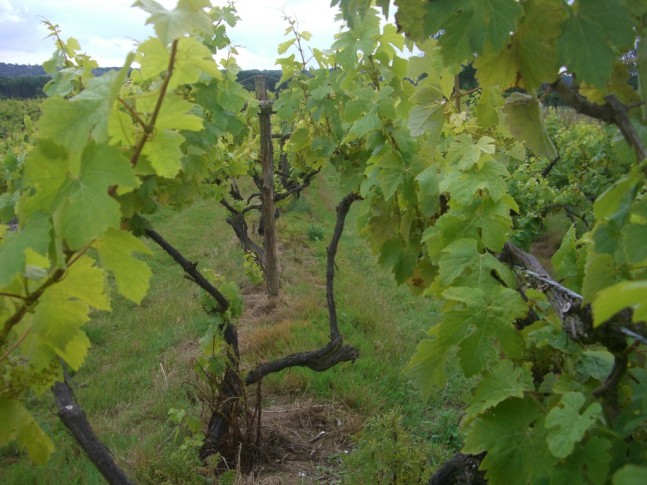
Trellising systems such as the double curtain and Lyre are used in England to maximize exposure of the vines to the sun
Sparkling wines Notes:
Breaky Bottom, Seyvel Blanc, Cuvée Réservée Brut, East Susses, Lewes, 12%, £23, Quality Sparkling
Pale green with a good consistent stream of bubbles. Light spiciness on the nose with lemon curd, a light creaminess, medium minus intensity. On the palate, flinty, lots of mineral, citrus lemon, long length and well-structured. The palate has more intensity than the nose.
*Gusbourne Brut Reserve, 2007, Kent, 12%, £26.99, Quality Sparkling,
Pale green and a very good stream of bubbles. Nose of ginger, cumquats, confectionary, apricots, light lees, med(+) intensity. On the palate, ginger, Japanese pickles, med(+) intensity, med(+) acid, medium alcohol, very long finish of citrus and nuts. A delicate wine.
Nyetimber, Classic Cuvee Brut, Chardonnay, 23% Pinot Noir, 22% Pinot Meunier, 2006, 12%, Quality sparkling, Sussex
3 years in lees. Small beads with long persistence, pale yellow colour. The nose is yeasty, developed, bread, red fruit ,brioche, med Intensity. On the palate, yeast, light bread, lees, pronounced flavours, high acid, red fruit and balanced, Beautiful with nuttiness
Sandyford Vineyard, Bacchus/ Reichensteiner, 2004, 12%, Quality sparkling wine, Essex
Brut. Pale straw colour. Small consistent beads. Nose of light toast, limestone, citrus, still has smell fruit. Palate is toasty, with lees, citrus lime, flavours with a minerality to it, long length due to acid and a mineral finish
Still Wine:
Avonleigh, “Triomphe d’alsace” Rosé, Dornfelder, 2009, Wiltshire, 11%, £11.90
Organic wine and Dornfelder is the grape. Pale ruby colour. A light confectionary smell with watermelon. The palate has high acid, long length of cantaloupe and raspberry.
Recommended to go with mussels.
Hush Heath, “Nannettes” Rosé, Pinot Noir/Chardonnay/Meunier, Kent, 11%
Pale onion colour. Light strawberries, med minus intensity. On the palate, high acid, delicate, tingly, light forest berries, medium length, light finish.
Sharpham, Madeleine Angevine, 2009, 11.5%, South Devon, ₤13
Barrel Fermented in 2nd year US oak. Under cork.
Pale green colour. Nose of custard, med Intensity, yoghurt, orange pips, lemon curd, an iodine smell. The palate is creamy, slight jackfruit, med plus acid, a papaya sort of flavour. Has a sort of lemon curd and passionfruit flavour in the mid palate, Med length with a iodine and slight nut tang to it.
The nose is quite unique and has a nose of exotic and flesh fruit (jackfruit, mango, mangosteen, esp soursop), even white pepper but I find the palate falling slightly short. It is not an elegant wine but it is definitely crafted to international standard. It has that gruner white pepper smell to it
Re-tasted 48 hours: Nose is custardy, yoghurt with lemon curd hints, again not much change. Jackfruit aromas are still there. Has a sort of more mineral, silvaner smell to it that resembles eraser and whiteout. The alcohol and acid seems higher now.
Biddenden, Gribble Bridge, Ortega, 2010, 11%, Kent, €11
Under cork. Ortega is the grape.
Pale green colour. The nose is medium(-) Intensity, peach, melon, vinous notes. The palate is high acid, lots of peaches, like a peach tea from Lipton. Short length, peachy finish.
After 3 days: On the finish, it taste more winter melon and chrysanthemum to me now.
New Hall, Bacchus, 2010, 10.5%, Essex, ₤9.50
The colour is pale green. Nose of uncanny spicy, smells like the sauce they use for Singapore black pepper crab and the coriander, med plus Intensity, something savoury in there, piquant on the nose, hints of guava and lemon grass, a sharp spiciness to it that you can’t miss like the gewurtz.
On the palate, slight spritz to it, high acid, low alch, med sweet, a sort of spicy gewurtz thing to it, long length extended by sweetness and some hints of apricot/peach flavour, also some spice in the back. It resembles viognier except it is sweet.
After a day, this is starting to smell like aloe vera more.
Giffords Hall, Bacchus, 2010, Suffolk, 10.5%
Pale green colour. Very funky nose of coriander, spice and lemon grass. On the palate, high acid, lemon thyme, lemon grass, long length.
Astley, Domain J², Veritas, Kerner, 2009, Worcestershire, 12%, £14.20
Kerner is the grape. This wine is recommended by people at wine pantry to go with scallops and black pudding. Light green appearance. A nose of light fragrance, melon, light chutney, medium intensity. On the palate, chutney mango, high acid, long length and a heavy finish. A oily palate but freshness to it.
Strawberry Hill, Cabernet Sauvignon, 2008, Gloucestershire, 11%, £13.80, Regional wine
An interesting wine. Even with the cold climate of England, they managed to grow this grape in a Victorian glasshouse. Pale tawny in colour. The nose is herbaceous, light black pepper, green chillies and medium intensity. On the palate, flavours of stalks, some herbaceousness, light currants, med(+) length, green bell peppers.
Welcombe Hills Vineyard, Pinot Noir, 2009, Warwickshire, 12%, £14, Regional Wine
Pale purple colour. Light peppery nose with beetroot. On the palate, slightly green, cranberry, medium tannins, slight rough texture, med length, juicy.
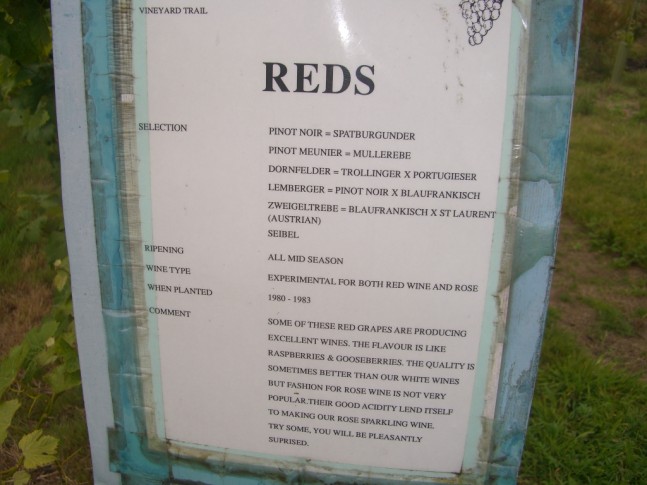
Experimental English Varietals at Carr Taylor vineyard
|
|
Tweet |






2 Comments to The Rise of the English – the New Frontier of Wines and the Wine Pantry in London | Comments Feed
If the restaurant ofrefs white chianti (though this is rather rare), that would probably suit your tastes. Reislings are also very sweet. Most restaurants will allow you to sample wines that they pour by the glass. Stop by the bar before going to your table and ask the bartender if you can try a few.You may also want to check out the dessert wine section. My favorite wine ever is Moscato d’Asti, a sparkling Italian varietal that is like extremely sweet champagne.
I’ve used your opinions many times to guide me to wines which cater to my precfrenees. I’ve never been disappointed. You have a good understanding of balancing food flavors and textures with wines to bring out the most flavorful combinations. It’s quite an art! Simply enjoying a good bottle of wine with friends is an excellent reason to look up your recommendations. Having your website for easy access to wine information will make wine shopping even more fun.
The comments are closed.